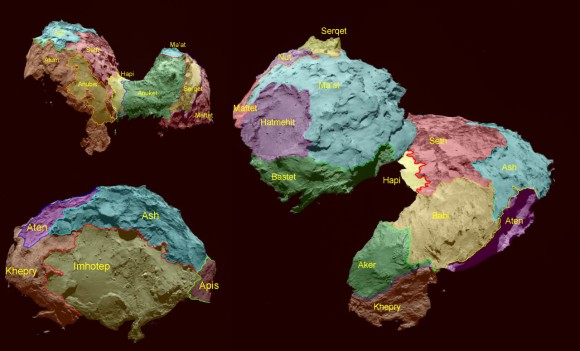
Scientists have defined 19 regions on Comet 67P/Churyumov-Gerasimenko’s nucleus according to terrain and named for Egyptian deities like Imhotep, Aten and Hathor. Credits: ESA/Rosetta/MPS/OSIRIS Team/UPD/LAM/IAA/SSO /INTA/UPM/DASP/IDA
Posted on 01/24/2015 8:47:49 PM PST by BenLurkin
Despite its solid appearance, 67P is highly porous with a density similar to wood or cork and orbited by a cloud of approximately 100,000 “grains” of material larger than 2 inches (5 cm) across stranded there after the comet’s previous perihelion passage.
...
Researchers have identified 19 distinct geological regions on the comet and five basic types of terrain: dust-covered, brittle material, large-scale depressions, smooth terrains and consolidated surfaces.
...
Using a spectrometer to scan the comet’s surface researchers discovered complex organic (carbon-based) molecules that could include carboxylic acids – a component of amino acids. These organics only form in deep space where cosmic rays and ultraviolet light strike ice-coated dust to energize the creation of new compounds. Finding them in 67P could indicate that the comet formed farther from the Sun than expected and therefore may be more pristine than other comets. Finally, water vapor given off by 67P has been analyzed and discovered to have a higher amount of deuterium to hydrogen compared to water on Earth, indicating that 67P and its brethren were probably not responsible for seeding our planet’s oceans.
...
Churyumov-Gerasimenko is active right now and will only become more so as it approaches perihelion this summer. Expect the landscape to transform before our eyes. Cliffs that look solid now will give way and crumble, pits will break their silence and erupt as geysers as chunks of comet take flight. Here on Earth the tumult will reveal itself as an delicate coma followed by the streak of a tail.
(Excerpt) Read more at universetoday.com ...

very interesting
And Vibrant!
Not much water there. So much for the “dirty snowball” theory of comets.
Wormwood.
You never know.
I see what you’re doing....
Comet Ping.
Despite its solid appearance, 67P is highly porous with a density similar to wood or cork and orbited by a cloud of approximately 100,000 "grains" of material larger than 2 inches (5 cm) across stranded there after the comet's previous perihelion passage.Extra to APoD.
That’s one short term comet that has made millions of passes around the sun. I would expect the water to be baked out of it long ago.
Comets that never cross the ice line are a whole different animal in my book.
Disclaimer: Opinions posted on Free Republic are those of the individual posters and do not necessarily represent the opinion of Free Republic or its management. All materials posted herein are protected by copyright law and the exemption for fair use of copyrighted works.